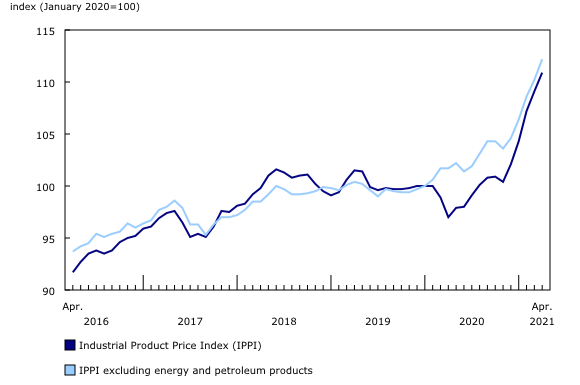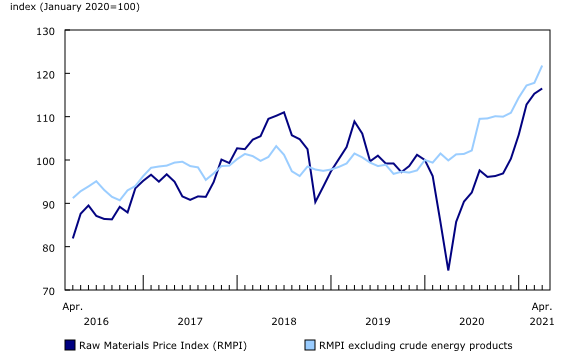Industrial product and raw materials price indexes, April 2021
Archived Content
Information identified as archived is provided for reference, research or recordkeeping purposes. It is not subject to the Government of Canada Web Standards and has not been altered or updated since it was archived. Please "contact us" to request a format other than those available.
Released: 2021-05-31
Prices for products manufactured in Canada, as measured by the Industrial Product Price Index (IPPI), rose 1.6% month over month in April and 14.3% compared with April 2020. Prices of raw materials purchased by manufacturers operating in Canada, as measured by the Raw Materials Price Index (RMPI), increased 1.0% on a monthly basis in April and 56.4% compared with April 2020.
Industrial Product Price Index
The IPPI (+1.6%) posted its fifth consecutive monthly increase in April. Excluding energy and petroleum products, the IPPI was up 1.8%. Of the 21 major commodity groups, 18 were up and 3 were down.
The increase in the IPPI was driven mostly by higher prices for lumber and other wood products (+6.4%), which have been on the rise since December 2020. Steadily increasing prices for softwood lumber (+10.1%) led this growth. Over one year, softwood lumber prices have climbed 169.4%, their largest year-over-year increase in history. Persistent demand for softwood lumber in the United States and Canada for construction and residential renovations, combined with lower supply, drove this category upward.
Prices for meat, fish and dairy products (+4.1%) also contributed significantly to the gain in the IPPI, mainly as a result of higher prices for fresh and frozen beef and veal (+17.0%) and, to a lesser extent, fresh and frozen pork (+7.3%). High domestic demand for red meat and strong exports were the main reasons for the higher prices for meats.
Primary ferrous metal product prices (+2.9%) rose for the eighth consecutive month in April, pulled upward by hot-rolled iron and steel products (+3.4%), and iron and steel pipes and tubes (except castings; +11.0%).
Prices for chemicals and chemical products were up 1.5% in April, following a 3.6% increase in March. Much of this gain was led by continuing price increases in plastic resins, which rose 7.8% from the previous month and 50.5% year over year. Petrochemicals (+1.5%) and chemical products not elsewhere classified (+3.7%) also pushed this commodity group upward, albeit to a lesser extent.
Among the other product groups that rose in April were pulp and paper products (+3.6%) and fruit, vegetables, feeds and other food products (+1.4%).
The gain in the pulp and paper product group was widespread, but wood pulp (+7.1%) was mostly responsible for the higher prices in this group.
The gain observed in fruit, vegetables, feeds and other food products was driven by higher prices for grain and oilseed products not elsewhere classified (+5.7%) and margarine and cooking oils (+8.4%).
Year over year, the IPPI was up 14.3%, its ninth consecutive increase and the strongest gain since February 1980 (+15.3%). Prices for energy and petroleum products (+78.4%) led this increase. The increase in prices for energy and petroleum products was pronounced because it followed a sharp decline in prices observed in April 2020, which was mainly caused by the COVID-19 pandemic. Lumber and other wood products (+88.8%) and primary non-ferrous metal products (+30.0%) were also important factors in the IPPI's year-over-year increase.
Raw Materials Price Index
The RMPI increased 1.0% in April, after posting a 2.2% gain in March. This was its seventh consecutive monthly gain. Of the six major commodity groups, five were up and one was down.
The RMPI excluding crude energy products (+3.4%) grew at a stronger pace, mostly from higher prices for animals and animal products (+8.7%). Prices for fish, crustaceans, shellfish and other fishery products (+33.1%) were the biggest contributor to the advance in this commodity group. This gain was primarily because of high demand for lobster and snow crab. Prices for hogs (+11.9%) and cattle and calves (+4.3%) also contributed significantly to higher prices for animals and animal products.
Crop products prices rose 3.4%, led by higher prices for canola (+5.3%), which continued their upward movement that began in March 2020. Year over year, canola prices climbed 82.3%, their strongest gain since June 1984 (+90.6%). Prices for grains except wheat (+5.2%) and oilseeds except canola (+2.6%) also rose over March.
The growth in the RMPI was mostly moderated by crude energy product prices, which fell 3.2% after five consecutive months of increase. Lower prices for conventional crude oil (-2.8%) and synthetic crude oil (-5.7%) were the main contributors to this decrease. A number of factors had a dampening effect on oil prices in April, including the decision of member countries of the Organization of the Petroleum Exporting Countries Plus to boost their production for the next three months, the uncertainty generated by a resurgence of COVID-19 cases in some Asian and European countries, and the reopening of the Suez Canal. Despite a decline in crude energy product prices in April, prices were 253.3% higher than in the same month in 2020. This increase was pronounced because it followed a large drop in prices observed in April 2020, caused mostly by the COVID-19 pandemic.
Year over year, the RMPI rose 56.4%, the largest increase since the start of this series in 1981. All six major commodity groups were up, compared with April 2020, but it was mostly crude energy products that pushed the RMPI upward.
Note to readers
The Industrial Product Price Index (IPPI) and the Raw Materials Price Index (RMPI) are available at the Canada level only. Selected commodity groups within the IPPI are also available by region.
With each release, data for the previous six months may have been revised. The indexes are not seasonally adjusted.
The Industrial Product Price Index reflects the prices that producers in Canada receive as goods leave the plant gate. The IPPI does not reflect what the consumer pays. Unlike the Consumer Price Index, the IPPI excludes indirect taxes and all costs that occur between the time a good leaves the plant and the time the final user takes possession of the good. This includes transportation, wholesale and retail costs.
Canadian producers export many goods. They often indicate their prices in foreign currencies, especially in US dollars, and these prices are then converted into Canadian dollars. In particular, this is the case for motor vehicles, pulp and paper products, and wood products. Therefore, fluctuations in the value of the Canadian dollar against its US counterpart affect the IPPI. However, the conversion to Canadian dollars reflects only how respondents provide their prices. This is not a measure that takes into account the full effect of exchange rates.
The conversion of prices received in US dollars is based on the average monthly exchange rate established by the Bank of Canada and available in Table 33-10-0163-01 (series v111666275). Monthly and annual variations in the exchange rate, as described in the release, are calculated according to the indirect quotation of the exchange rate (for example, CAN$1 = US$X).
The Raw Materials Price Index reflects the prices paid by Canadian manufacturers for key raw materials. Many of those prices are set on the world market. However, as few prices are denominated in foreign currencies, their conversion into Canadian dollars has only a minor effect on the calculation of the RMPI.
Products
Statistics Canada launched the Producer price indexes portal as part of a suite of portals for prices and price indexes. This web page provides Canadians with a single point of access to a variety of statistics and measures related to producer prices.
The video Producer Price Indexes is available on the Statistics Canada Training Institute web page. It provides an introduction to Statistics Canada's producer price indexes—what they are, how they are made and what they are used for.
Next release
The industrial product and raw materials price indexes for May will be released on June 30, 2021.
Contact information
For more information, or to enquire about the concepts, methods, or data quality of this release, contact us (toll-free 1-800-263-1136; 514-283-8300; STATCAN.infostats-infostats.STATCAN@canada.ca) or Media Relations (613-951-4636; STATCAN.mediahotline-ligneinfomedias.STATCAN@canada.ca).
- Date modified:




